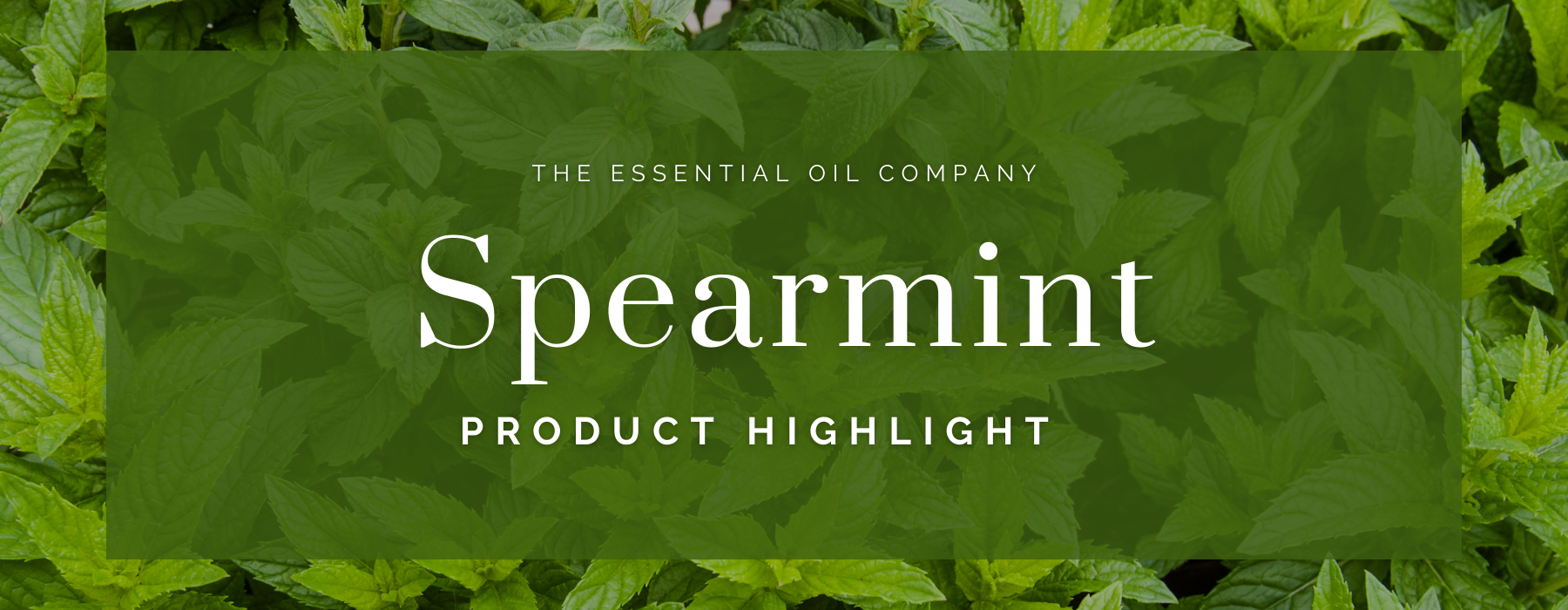
Spearmint: Product Highlight
Plant Details
Spearmint (Mentha spicata), also referred to as garden mint, lamb mint, and common mint, is a perennial herb in the Lamiaceae family. It is native to areas across Europe and Asia and has become naturalized in temperate regions of North America, South America, the Mediterranean, and southern Africa. Spearmint grows from twelve to forty inches tall and has square stems characteristic of the minty family which can be smooth or have fine hairs. Spearmint leaves are bright green and oblong, narrowing to a pointed tip. The name ‘spearmint’ derives from the pointed leaf tips which resemble spearheads. Spearmint leaves are generally two to three and a half inches long and a half inch to one inch broad, with serrated edges. The flowers of the Spearmint plants bloom in summer, growing in clusters on slender, two to four inch spikes. The flowers are small, only a few millimeters across, and can range in color from white to light pink or purple. Spearmint can grow in conditions from shade to full sun but flourishes in partial shade with moist and adequately draining soil.
History
The common name ‘Spearmint’ comes from the spear-like shape of the plant's leaves while the scientific name ‘spicata’ means “bearing a spike” which refers to the plant's flower spikes. Spearmint has been used for centuries for its digestive benefits and it was often served alongside or after meals to combat stomach upset, nausea, gas, and bloating. The herb was also used in Ayurvedic medicine for the same purpose as well as being utilized to help soothe skin issues and to ease the pain of headaches. Spearmint has been described in history as early as the first century CE, with mentions of the herb in the Christian bible and other ancient mythological texts. Swedish biologist Carl Linnaeus was the first to scientifically describe the Spearmint species in the eighteenth century. Early versions of toothpaste from the fourteenth-century feature mint flavoring, suggesting widespread domestication of Spearmint had been established by that time. In Greece, Spearmint was used to scent bath water and was seen as an aphrodisiac. Spearmint was brought to England by Romans in the fifth century and there its medicinal properties finally became more well-known. It began to be used to relieve nausea, vomiting, and other stomach upsets as well as being utilized to soothe respiratory issues, including symptoms of the common cold. William Turner, a botanist known as the "Father of British Botany" mentions Spearmint as being good for stomach ailments. English herbalist John Gerard writes of Spearmint in his 1597 Herbal, stating that it is “ good against watering eyes and all manner of break outs on the head and sores.” and that "They lay it on the stinging of wasps and bees with good success." Of the aroma of Spearmint Gerard says "the smell rejoices the heart of man", for which reason they used to strew it in chambers and places … where feasts and banquets are made." During the American Revolution, Spearmint is documented as an important cash crop in Connecticut. Mint tea was a popular drink during this time due to it not being taxed like other teas.
Extraction
Spearmint is harvested just before the plant begins flowering or just as the flowers begin to open when the essential oil content is at its maximum. Plants can be harvested two to three times each season in good growing conditions. Harvest ideally takes place in the morning on a sunny and dry day before the Spearmint plants begin to wilt in the sunny. Spearmint plants are cut one to inches above ground level, either by hand with shears or mechanically with hay mowers or sickle bar mowers. After cutting, the plant material is gathered in bunches. Some producers will then load the fresh Spearmint into machinery to be chopped and then transfer it to a mobile still to be distilled in the field. In other instances, the Spearmint will be placed in a warm shaded area to dry for a day before being transported to the distillation facility. Spearmint Essential Oil is extracted from the leaves and flowering tops of the plant through steam distillation. The resulting essential oil is thin and colorless to pale yellow in color, with a fresh, sweet, and herbaceous minty aroma.
Benefits & Uses
When used in aromatherapy, the refreshing and invigorating aroma of Spearmint Essential Oil is known as a beacon of rejuvenation. It has been found to soothe feelings of stress and anxiety, offering respite from mental fatigue and tension. Spearmint is believed to evoke a sense of clarity and tranquility, promoting relaxation and overall well-being. It is known to relax the brain and body, helping to relieve headaches, reduce symptoms of illness, and ease feelings of negativity. Spearmint Essential Oil has been found to enhance concentration and memory retention when diffused during work or study, and its revitalizing properties may help uplift the mood and bring emotions into balance.
Diluted and used topically, Spearmint Essential Oil is thought to possess cleansing and anti-inflammatory properties, making it a formidable force against skin concerns. It has been found to combat acne, reduce redness, and soothe blemishes. The cooling sensation of Spearmint Essential Oil may help ease discomfort in irritated skin and leave the skin feeling refreshed and revitalized. Antioxidant properties may make Spearmint useful in reducing the appearance of wrinkles and skin imperfections, including discoloration, promoting a more youthful complexion. Spearmint Essential Oil is believed to support healthy skin cell regeneration, enhancing skin resilience and improving elasticity over time. It is also thought to serve as an ideal skin cleanser, helping to unclog pores and imparting a cooling sensation that relieves itching associated with dryness and leaves the skin feeling cool and refreshed. Spearmint is believed to provide relief from aches, pains, and muscle spasms while also working to alleviate fever, fatigue, inflammation, and other symptoms of illness. Spearmint Essential Oil is known to support healthy digestive functions and has been recognized for easing the discomfort of menstrual issues like abdominal pain and cramping.
Spearmint Essential Oil may assist in treating Varroa mites when used in the keeping of honeybees. It may also be used to mask scents while not mimicking any of the honeybee’s pheromones, working to deter predator species and protect the hive. Spearmint is often used in combination with lemon grass oil during feeding to help improve overall hive health.
Here are some recipes using Spearmint Essential Oil that we love...

Breath of Fresh Air Diffuser Blend
- 3 drops of Spearmint Essential Oil
- 3 drops of Peppermint Essential Oil
- 2 drops of Eucalyptus Essential Oil
- 2 drops of Lavender Essential Oil
Diffuser Instructions
Add water to the diffuser up to the fill line. Add drops of the essential oil blend. This diffuser blend recipe is formulated for a 200ml ultrasonic diffuser. Adjust the amount according to the size and directions of the diffuser.
Minty Blossom Calming Facial Toner
Ingredients
- 4oz Amber Glass Bottle
- 2 oz of Witch Hazel Extract
- 1 oz of Distilled Water
- ½ oz of Sweet Almond Oil
- 20 drops of Spearmint Essential Oil
- 20 drops of Geranium Essential Oil
- 10 drops of Chamomile Essential Oil
Instructions
Mix all ingredients in a 4 oz glass amber bottle and shake well to combine. To use, soak a cotton round with the toner and then gently rub it over the face and neck. Shake well before each use. Store in a cool dark place for extended shelf life.
![]()
Beacon of Rejuvenation Uplifting Room Spray
Ingredients
- 4 oz Amber Glass Bottle with Spray Top
- 2 oz of High Percentage Alcohol
- 2 oz of Witch Hazel Extract
- 30 drops of Spearmint Essential Oil
- 20 drops of Grapefruit Essential Oil
- 20 drops of Rosemary Essential Oil
- 10 drops of Bergamot Essential Oil
Instructions
Add 2 oz of high-percentage alcohol to the bottle. Add the essential oils and fill the remainder of the bottle with witch hazel, leaving a little space at the top. Shake well before each use. Spray all around the home.
Cool & Calm Massage Oil
Ingredients
- 4oz Amber Glass Bottle
- 2oz of Fractionated Coconut Oil
- 1oz of Sweet Almond Oil
- 1/2oz of Jojoba Oil
- 20 drops of Spearmint Essential Oil
- 20 drops of Lavender Essential Oil
- 10 drops of Black Pepper Essential Oil
Instructions
Add all ingredients to a 4-ounce amber glass bottle and shake vigorously to combine. Pour a small amount into the hands and gently massage into the desired area.

Healthy Hive Beekeeping Essential Oil Syrup
Ingredients:
- 5 cups of Water
- 2 ½ pounds of Sugar
- 1/8 teaspoon of Lecithin Granules
- 15 drops of Spearmint Essential Oil
- 15 drops of Lemongrass Essential Oil
Instructions
Bring the water to a boil and add the sugar, stirring until the sugar is completely dissolved. Remove it from heat and quickly add lecithin and essential oils. Stir the mixture until everything is combined. The mixture can also be added to a blender as the lecithin granules can sometimes be difficult to incorporate. Cool completely before use. Do not leave the mixture open around bees.
To use, add 1 teaspoon per quart of 1:1 sugar syrup to stimulate brood rearing, pollen collection, and early spring development. Add 2 teaspoons per quart of 1:1 sugar syrup to improve health or to help against cases of dysentery, chalkbrood, and other stress problems. Add 4 teaspoons per quart of 1:1 sugar syrup when introducing new queens. You will likely need to drizzle this over the bees, or they won’t eat it on their own.







